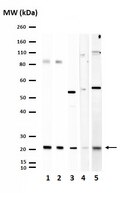The matricellular protein CCN1 induces fibroblast senescence and restricts fibrosis in cutaneous wound healing.
Jun, JI; Lau, LF
Nature cell biology
12
676-85
2010
Show Abstract
Cellular senescence is a recognized mechanism of tumour suppression; however, its contribution to other pathologies is not well understood. We show that the matricellular protein CCN1 (also known as CYR61; cysteine-rich protein 61), which is dynamically expressed at sites of wound repair, can induce fibroblast senescence by binding to integrin alpha(6)beta(1) and the heparan sulphate proteoglycans (receptors involved in cell adhesion). CCN1 induces DNA damage response pathways and activates p53 and the RAC1-NOX1 complex, which generates reactive oxygen species (ROS). This results in the ROS-dependent activation of the p16(INK4a)/pRb pathway, leading to senescence and concomitant expression of antifibrotic genes. Senescent fibroblasts accumulate in granulation tissues of healing cutaneous wounds and express antifibrotic genes in wild-type mice. These processes are lost in knockin mice that express a senescence-defective Ccn1 mutant, resulting in exacerbated fibrosis. Topical application of CCN1 protein to wounds reverses these defects. Thus, fibroblast senescence is a CCN1-dependent wound healing response in cutaneous injury that functions to curb fibrosis during tissue repair. | Western Blotting | 20526329
 |









